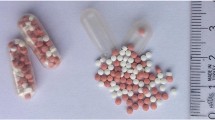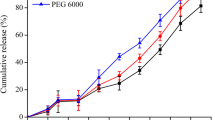Abstract
The purpose of this study was to develop and evaluate a colon-specific, pulsatile drug delivery system, which consists of an impermeable capsule body filled with a 5-aminosalicylic acid rapid-disintegrating tablet and a pectin-based erodible plug placed in the opening of the capsule body. To obtain an appropriate gel-forming ability and suitable lag time for the colon-specific drug delivery, high-methoxy pectin (HM-pectin) was formulated with lactose and lowmethoxy pectin (LM-pectin) with HPMC to prepare the plug tablet. In order to evaluate the lag time, prior to the rapid drug release, both the formulation of the plug tablet and in vitro release medium were studied. The lag time prior to the rapid drug release was mainly determined by the HM-pectin/lactose or LM-pectin/HPMC ratio. The addition of pectinase or rat cecal content into the release medium shortened the lag time significantly, which predicted the probable enzyme sensitivity of pectin plug tablet. In vivo studies showed that the plasma concentration of drug can only be detected 6h after oral administration of the pulsatile capsule, which indirectly proved the colon-specific characteristics. These results show that the pulsatile capsule may have the therapeutic action for colon-specific drug delivery.
Similar content being viewed by others
References
Bigucci, F., Luppi, B., Monaco, L., Cerchiara, T., and Zecchi, V., Pectin-based microspheres for colon-specific delivery of vancomycin. J. Pharm. Pharmacol., 61, 41–46 (2009).
Fan, L. F., He, W., Bai, M., Du, Q., Xiang, B., Chang, Y. Z., and Cao, D. Y., Biphasic drug release: permeability and swelling of pectin/ethylcellulose films, and in vitro and in vivo correlation of film-coated pellets in dogs. Chem. Pharm. Bull. (Tokyo), 56, 1118–1125 (2008).
Freire, C., Podczeck, F., Veiga, F., and Sousa, J., Influence of the coating formulation on enzymatic digestibility and drug release from 5-aminosalicylic acid pellets coated with mixtures of high-amylose starch and Surelease intended for colon-specific drug delivery. Drug Dev. Ind. Pharm., 36, 161–172 (2010).
Friend, D. R., New oral delivery systems for treatment of inflammatory bowel disease. Adv. Drug Deliv. Rev., 57, 247–265 (2005).
Gazzaniga, A., Maroni, A., Sangalli, M. E., and Zema, L., Time-controlled oral delivery systems for colon targeting. Expert Opin. Drug Deliv., 3583–3597 (2006).
Gliko-Kabir, I., Yagen, B., Baluom, M., and Rubinstein, A., Phosphated crosslinked guar for colon-specific drug delivery. II. In vitro and in vivo evaluation in the rat. J. Control. Release, 63, 129–134 (2000).
Gupta, V. K., Beckert, T. E., and Price, J. C., A novel pH- and time-based multi-unit potential colonic drug delivery system. I. Development. Int. J. Pharm., 213, 83–91 (2001).
He, W., Qing, D., Cao, D. Y., Fan, L. F., and Xiang, B., Selective drug delivery to the colon using pectin-coated pellets. PDA J. Pharm. Sci. Technol., 62, 264–272 (2008).
Hinton, J. M., Lennard-Jonnes, J. E., and Young, A. C., A new method for studying gut transit times using radioopaque markers. Gut, 10, 842–847 (1969).
Jones, S. P., Preparation and evaluation of a time-controlled release capsule made of ethylcellulose for colon delivery of drugs. J. Drug Target, 3477–3478 (1996).
Kaus, L. C., Fell, J. T., Sharma, H., and Taylor, D. C., The intestinal transit of a single non-disintegrating object. Int. J. Pharm., 14, 143–148 (1984)
Khan, M. Z., Stedul, H. P., and Kurjakovic, N., A pH-dependent colon-targeted oral drug delivery system using methacrylic acid copolymers. II. Manipulation of drug release using Eudragit L100 and Eudragit S100 combinations. Drug Dev. Ind. Pharm., 26, 549–554 (2000).
Krogel, I. and Bodmeier, R., Pulsatile drug release from an insoluble capsule body controlled by an erodible plug. Pharm. Res., 15, 474–481 (1998).
Krogel, I. and Bodmeier, R., Development of a multifunctional matrix drug delivery system surrounded by an impermeable cylinder. J. Control. Release, 61, 43–50 (1999a).
Krogel, I. and Bodmeier, R., Evaluation of an enzyme-containing capsular shaped pulsatile drug delivery system. Pharm. Res., 16, 1424–1429 (1999b).
Kumar, P. and Mishra, B., Colon targeted drug delivery systems—an overview. Curr. Drug Deliv., 5, 186–198 (2008).
McConnell, E. L., Liu, F., and Basit, A. W., Colonic treatments and targets: issues and opportunities. J. Drug Target, 17, 335–363 (2009).
Peerapattana, J., Otsuka, K., and Otsuka, M., Time-controlled pulse-drug release from dry-coated wax matrix tablets for colon drug delivery. Biomed. Mater. Eng., 14, 293–301 (2004).
Pertuit, D., Moulari, B., Betz, T., Nadaradjane, A., Neumann, D., Ismaili, L., Refouvelet, B., Pellequer, Y., and Lamprecht, A., 5-amino salicylic acid bound nanoparticles for the therapy of inflammatory bowel disease. J. Control. Release, 123, 211–218 (2007).
Sriamornsak, P., Application of pectin in oral drug delivery. Expert Opin. Drug Deliv., 8, 1009–1023 (2011).
Tozaki, H., Emi, Y., Horisaka, E., Fujita, T., Yamamoto, A., and Muranishi, S., Degradation of insulin and calcitonin and their protection by various protease inhibitors in rat caecal contents: implications in peptide delivery to the colon. J. Pharm. Pharmacol., 49, 164–168 (1997).
Wong, T. W., Colombo, G., and Sonvico, F., Pectin matrix as oral drug delivery vehicle for colon cancer treatment. AAPS PharmSciTech, 12, 201–214 (2011).
Yehia, S. A., Elshafeey, A. H., and Elsayed, I., Pulsatile systems for colon targeting of budesonide: In vitro and in vivo evaluation. Drug Deliv., 18, 620–630 (2011)
Zhang, H. and Neau, S. H., In vitro degradation of chitosan by bacterial enzymes from rat cecal and colonic contents. Biomaterials, 23, 2761–2766 (2002).
Author information
Authors and Affiliations
Corresponding author
Rights and permissions
About this article
Cite this article
Liu, J., Zhang, L., Jia, Y. et al. Preparation and evaluation of pectin-based colon-specific pulsatile capsule in vitro and in vivo . Arch. Pharm. Res. 35, 1927–1934 (2012). https://doi.org/10.1007/s12272-012-1109-4
Received:
Revised:
Accepted:
Published:
Issue Date:
DOI: https://doi.org/10.1007/s12272-012-1109-4




